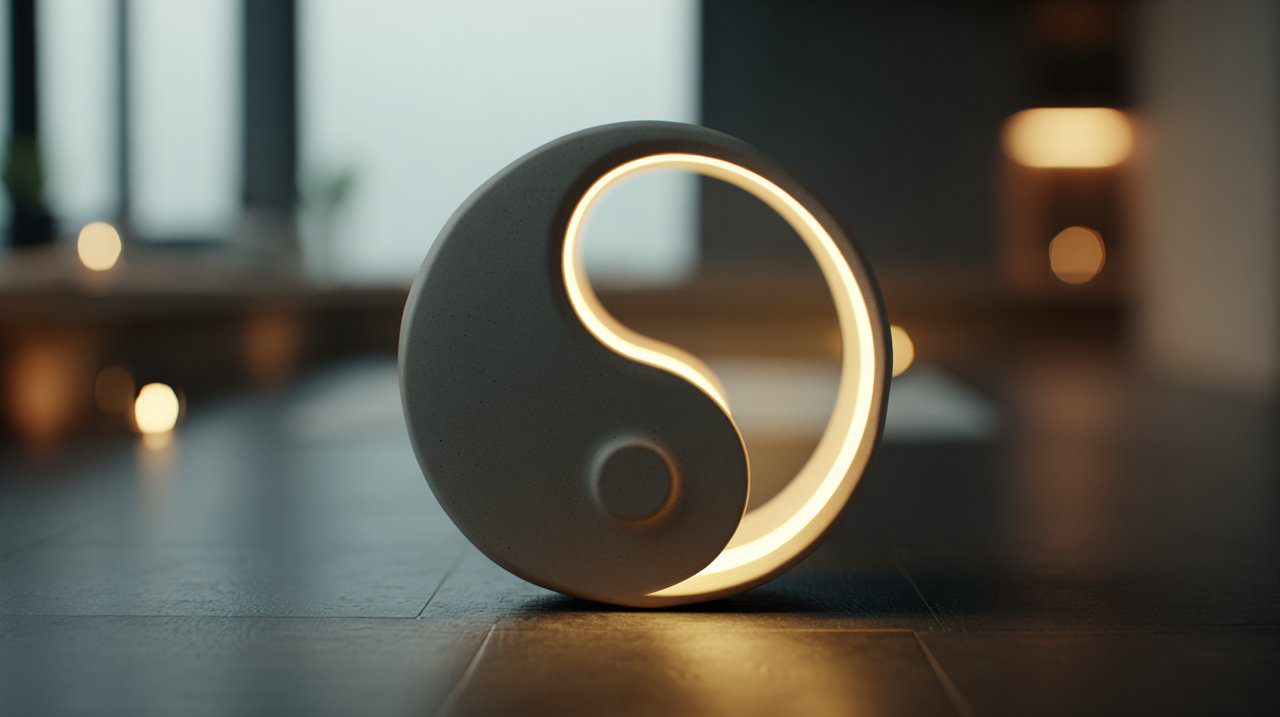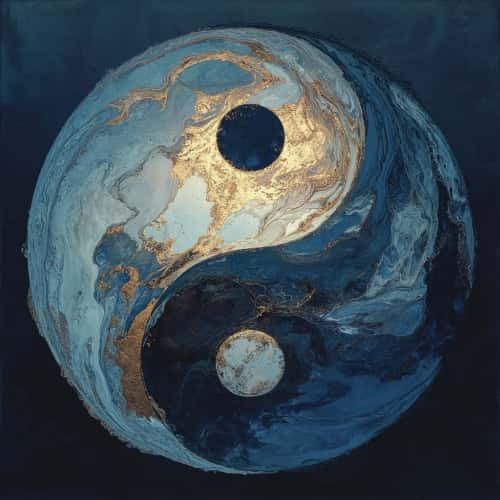The Silent Influence: How Yin Yang Necklaces Become Psychological Anchors
The Yin Yang as a Psychological Compass
The ancient, elegant Yin Yang symbol continues to fascinate us, deeply resonating in our often-chaotic modern world. It’s easy to wonder if its profound appeal comes from some mystical energy, a secret power beyond our understanding.
But as someone who’s always curious about how ancient wisdom meets modern logic, I’ve found a different, equally powerful explanation. I believe the Yin Yang’s true strength isn’t magic, but its remarkable ability to act as a potent visual and psychological anchor. These symbols are, in essence, sophisticated tools of environmental psychology, gently guiding us toward inner harmony and self-regulation.
This perspective fundamentally shifts how we think about ‘energy.’ It moves from an external, mysterious force to an internal, activated capacity within us. It encourages us to consciously engage with life’s inherent dualities, acting as a subtle nudge toward an active, self-regulating psychological practice. Much like a quiet meditation, this engagement can lead to profound internal shifts, reminding us that true balance always starts from within.

The Enduring Wisdom of Yin and Yang
“True balance is not about eradicating opposites, but integrating them.”
A Timeless Philosophy of Interconnectedness
At its heart, the Yin Yang symbol, with its elegant intertwining of dark and light, represents a foundational concept in ancient Chinese philosophy. It speaks to the interconnectedness and interdependence of forces that might seem opposite. It’s a deep recognition that light needs shadow, expansion needs contraction, and activity needs rest.
This isn’t just a static picture; it’s a dynamic representation of constant flow and balance. Think of it as a cosmic dance of complementary energies, a concept that has fascinated thinkers for thousands of years. It continues to offer powerful insights into our world today.
Why Duality Still Resonates Today
Even after millennia, the Yin Yang’s relevance endures because the fundamental human experience is still full of duality. We constantly navigate the tension between work and rest, logic and emotion, ambition and contentment. It’s a universal human condition, isn’t it?
The symbol gives us a timeless framework for understanding these inherent oppositions. It suggests they aren’t conflicts to be eliminated, but rather complementary aspects to be integrated. This isn’t just ancient wisdom; it aligns perfectly with modern psychological principles of adaptability, helping us find balance in an increasingly fragmented world.
Unpacking the Psychological Power of Symbols
“A symbol’s true power lies in its ability to activate the mind, not in mystical properties.”
The Visual Anchor Effect: A Mental Grounding Tool
So, how exactly does this ancient wisdom become a practical tool for our modern well-being? I invite you to see a Yin Yang symbol not just as a beautiful adornment, but as a subtle, ever-present visual cue.
This constant visual presence can act as a powerful psychological anchor, a concept deeply rooted in cognitive and environmental psychology. Think of it like an anchor stabilizing a ship in turbulent waters. When our inner world feels stormy, a visual anchor quietly grounds our thoughts and intentions.
It acts as a non-verbal reminder, a quiet prompt to return to a state of equilibrium amidst daily pressures. This effect taps into how elements in our surroundings subtly yet profoundly influence our internal states. It’s the same principle we see in how deeply personal symbols can serve as powerful emotional anchors The Significance of Meaningful Mental Health Tattoos: Emotional Benefits and How to Choose One.
Priming Our Minds for Balance: How It Works
What’s truly fascinating is how this works on a deeper level. The consistent visual input of the Yin Yang can engage our priming mechanisms. In psychology, priming refers to subtle cues that can influence our thoughts and behaviors without us even realizing it.
Imagine seeing a picture of a calm lake; it might unconsciously make you feel more relaxed. The Yin Yang works similarly. By consciously associating the symbol with balance, peace, and integration, we are, in essence, ‘priming’ our brains.
So, when you glance at it, your mind is subtly nudged towards those very states of being. It’s a powerful, non-verbal suggestion directly to your subconscious.
The Self-Regulation Trigger: Shifting from Conflict to Harmony
When we consciously, or even unconsciously, glimpse a Yin Yang symbol, it can act as a potent trigger for self-regulation. In moments of stress, indecision, or emotional imbalance, this visual cue prompts a subtle internal shift.
It’s like a gentle invitation to pause, reflect, and actively seek a more balanced perspective. The symbol doesn’t magically solve our conflicts, of course. Instead, it leverages our innate capacity for self-correction.
It’s a gentle whisper, not a loud command, reminding us to engage the mental frameworks we’ve built around its meaning. It encourages us to find harmony within ourselves, rather than always seeking external solutions.
Embodied Cognition: Wearing Your Intentions
This concept of ’embodied cognition’ is incredibly insightful. It suggests that our thoughts and decisions are deeply influenced by our physical states and how we interact with our environment. When you physically wear or regularly see a Yin Yang symbol, you’re not just observing it; you’re incorporating it into your physical experience.
This physical connection reinforces the mental association, making the idea of balance feel more tangible and accessible. Over time, this consistent interaction can lead to a kind of conditional response: the mere presence of the symbol becomes a conditioned stimulus, automatically triggering your internal ‘balance’ response. It’s a powerful way to make an abstract concept a felt reality.
My Friend’s Story: A Real-World “Pause Button”
Let me share a real-world example of this in action. I have a dear friend, let’s call him Mark, who was grappling with an intensely stressful period. He was juggling demanding work projects and significant family commitments, visibly strained and torn between competing priorities.
He felt overwhelmed, caught in a constant tug-of-war. One afternoon, as we spoke, I noticed him unconsciously adjusting a subtle Yin Yang pendant he wore. Later, he recounted that in that fleeting moment, the simple act of touching it, combined with its quiet visual presence, felt like an internal “pause button.”
It didn’t magically resolve his immediate dilemmas – no symbol can do that, of course. Instead, he explained, it served as a crucial cognitive interrupt and a catalyst for self-reflection. It prompted him to actively reconsider his allocation of energy, asking himself: “Where am I expending too much? Where do I need to create space?”
This subtle interaction provided a powerful reminder to engage his own coping mechanisms. It illustrated for me how a tangible symbol can facilitate mental re-centering and adaptive behavior far more effectively than any mystical solution could provide. It’s about activating what’s already within us.

Making Balance Tangible: Integrating Yin Yang into Your Life
“Your chosen symbol is more than an adornment; it’s a commitment to internal harmony.”
Choosing Your Personal Balance Companion
When selecting a Yin Yang symbol, your choice goes far beyond just aesthetics. It’s about picking a personal ‘balance companion’ – an object that truly resonates with your intention to cultivate harmony. So, how do you find that perfect companion?
The symbol’s effectiveness is greatly amplified when its meaning is deeply personal to you. This creates a stronger psychological link to its purpose, making it a more potent reminder. Consider its design, its material, and most importantly, how it makes you feel. This aligns with the psychological impact of other meaningful symbols worn as adornment, which can guide and inspire us Lotus Flower Necklace Meaning: Purity, Rebirth, and Spiritual Growth.
Daily Practice: The Continuous Reminder
Wearing the symbol daily transforms it from a simple object into a dynamic part of your personal environment. It’s a continuous, subtle psychological reminder, always within your peripheral awareness. This consistent visual cue reinforces your commitment to balance, making the abstract concept of Yin Yang a tangible part of your daily experience.
This consistent exposure functions as a form of active mindfulness. Think of it: every time you glimpse it, it’s a gentle prompt to check in with yourself. It ensures the principles of balance are regularly brought to the forefront of your consciousness, strengthening their influence on your thoughts and actions.
I like to think of the Yin Yang symbol as a psychological compass. It doesn’t dictate your path, nor does it magically clear the fog of uncertainty. Instead, it helps to calibrate your internal sense of direction, gently reminding you to check your bearings and adjust your course when feeling off-kilter. It ensures that, even in turbulent waters, you possess a reliable internal reference point for balance, a quiet, steady presence amidst the storm.
Practical Tip: Try to consciously acknowledge your Yin Yang symbol a few times a day. Take a deep breath, and mentally reaffirm your intention for balance. This simple practice can significantly enhance its anchoring effect.
Beyond the Symbol: Cultivating Inner Harmony
“Embracing duality unlocks new pathways for growth and resilience.”
Embracing Duality for Growth and Resilience
The philosophy of Yin Yang teaches us a profound truth: challenges are often opportunities in disguise, and apparent opposites are inherently complementary. It’s a mindset shift that can truly transform our lives.
This understanding encourages us to view setbacks not as failures, but as chances for growth. It helps us recognize that periods of rest are not unproductive, but essential for future creativity and productivity. It’s about embracing the full spectrum of human experience, recognizing that both light and shadow contribute to the richness of life.
This perspective fosters incredible resilience and adaptability. It helps shift our reactions from despair to curiosity when faced with unexpected hurdles. What if every challenge held a hidden opportunity for balance?
From Adornment to Active Practice
The ultimate goal, then, isn’t just to wear a symbol; it’s to internalize the profound philosophy it represents. The symbol serves as a tangible prompt, yes, but the true work of balance happens within each of us. It’s a daily practice of:
- Recognizing duality in our experiences.
- Accepting change as a constant, natural force.
- Actively seeking equilibrium in our thoughts, actions, and environments.
This active engagement transforms a beautiful piece of adornment into a powerful catalyst for profound personal growth. It fosters a deeper connection to one’s inner landscape, making the wisdom of Yin Yang a living, breathing part of who you are.
Your Journey to Internal Equilibrium
So, what’s the real ‘magic’ behind the enduring appeal of the Yin Yang? As we’ve explored, it’s not rooted in supernatural power. Instead, its profound effectiveness comes from its role as a psychological anchor and a powerful tool for self-regulation. It subtly guides us toward a more balanced and harmonious existence.
These symbols serve as constant, quiet reminders that the most profound ‘magic’ often resides within our own capacity for awareness and intentional living. By truly understanding this, we can begin to leverage ancient wisdom for modern well-being. This transforms not just our inner landscape, but also our physical environment to promote that internal balance 7 Fall Feng Shui Tips for Home Harmony.
It’s a journey of continuous calibration, not a fixed destination. It’s a fascinating, empowering journey, and I believe, a truly worthwhile one at that.
💡 Frequently Asked Questions
Its true appeal lies not in mystical energy, but in its capacity to function as a potent visual and psychological anchor. It acts as a subtle tool of environmental psychology, guiding individuals towards internal harmony by activating their engagement with life's inherent dualities.
The yin yang symbol fundamentally represents the interconnectedness and interdependence of seemingly opposite forces, embodying a dynamic representation of constant flux and balance in ancient Chinese philosophy.
It acts as a subtle, ever-present visual cue that can quietly ground one's thoughts and intentions, providing stability and serving as a non-verbal reminder to return to a state of equilibrium.
Beyond wearing the symbol, the ultimate aim is to internalize its profound philosophy, making it a daily practice of recognizing duality, accepting change, and actively seeking equilibrium in one's thoughts, actions, and environments.







